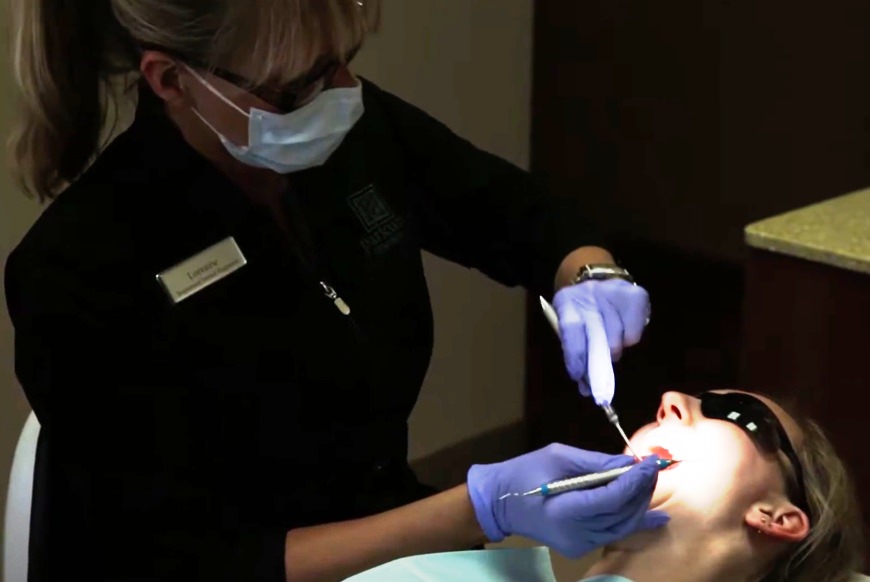 Scaling and root planing is necessary to remove difficult plaque and tartar buildup from your teeth, and under your gums and exposed roots. This non-surgical periodontal therapy is a deep cleaning that removes unhealthy toxins, calculus and microorganisms that cause uncomfortable gum inflammation and gum disease.
Scaling and root planing is necessary to remove difficult plaque and tartar buildup from your teeth, and under your gums and exposed roots. This non-surgical periodontal therapy is a deep cleaning that removes unhealthy toxins, calculus and microorganisms that cause uncomfortable gum inflammation and gum disease.
Do I Need Scaling & Root Planing?
A common question you may have is whether you should have scaling and root planing done—or if it is necessary. This will be determined by your dentist after performing a checkup of your mouth, and determining the health of your teeth and gums.
If you are experiencing bleeding and receding gums, loose teeth, and gum inflammation, you may have gum disease (periodontal disease). If gum disease is present, scaling and root planing is one of the first options used to treat the disease.
Scaling and root planing is highly effective if your mouth doesn’t respond to conventional oral treatments.
How Is The Procedure Done?
First a local anesthetic is applied to hinder discomfort. Next, an instrument called a scaler is used to remove plaque and tartar from under your gum line. Once that procedure is complete, the surface of the roots of your teeth are planed which is smoothing the surface of your teeth. This helps your gums reattach to the tooth and function optimally.
If the signs of periodontal disease persist after the procedure, additional measures to fight the disease may be needed.
Does Scaling & Root Planing Cure Gum Disease?
 Scaling and root planing is very effective at mitigating gum disease infections but it can’t do it alone. In order to effectively treat gum disease, you must take the advice of your dentist by flossing every day, brushing regularly, get deep teeth cleaning, and possibly use an antibiotic oral rinse for a period of time.
Scaling and root planing is very effective at mitigating gum disease infections but it can’t do it alone. In order to effectively treat gum disease, you must take the advice of your dentist by flossing every day, brushing regularly, get deep teeth cleaning, and possibly use an antibiotic oral rinse for a period of time.
Without scaling and root planing, the tarter and plaque build-up that’s combined with the toxins and microorganisms living in your mouth, will only get worse.
This is the point when teeth start falling out, gums recede, inflammation takes over and the rest of the health of your body is affected.
Read a Healthy Mouth Equals a Healthier Heart for more information on the health of your mouth and its connection to the health of your heart and the rest of your body.
Is There Any Pain To Scaling & Root Planing?
Scaling and root planing is generally painless. It is a non-surgical procedure and only requires local freezing to ease minor sensations of discomfort. The local anesthetic is effective especially when the gums and teeth are extra sensitive due to prolonged gum disease.
Occasionally the procedure causes minor discomfort in some patients, while others report enjoying the experience all together—knowing that their teeth are getting deep cleaned.
How Often Should Scaling & Root Planing Be Done?
How often should scaling and root planing be done? When gum disease is present, this procedure is highly recommended, and your dentist will advise you to have it done at least twice a year. If you’re practicing proper and regular oral hygiene, scaling and root planing should be done at least once a year.
How Long Does Scaling & Root Planing Take?
The time it takes to complete the procedure is approximately one hour. Scaling and root planing is a two-step procedure that may take more than one appointment depending on the condition of your teeth and gums. The procedure may only need one visit, or up to several visits to ensure the toxins, calculus, microorganisms, plaque and tarter is properly removed.
Get In Touch With Us
If you would like more information about the procedure, feel free to give our office a call at 519-720-9119. We’d love to hear from you and answer any of your questions.